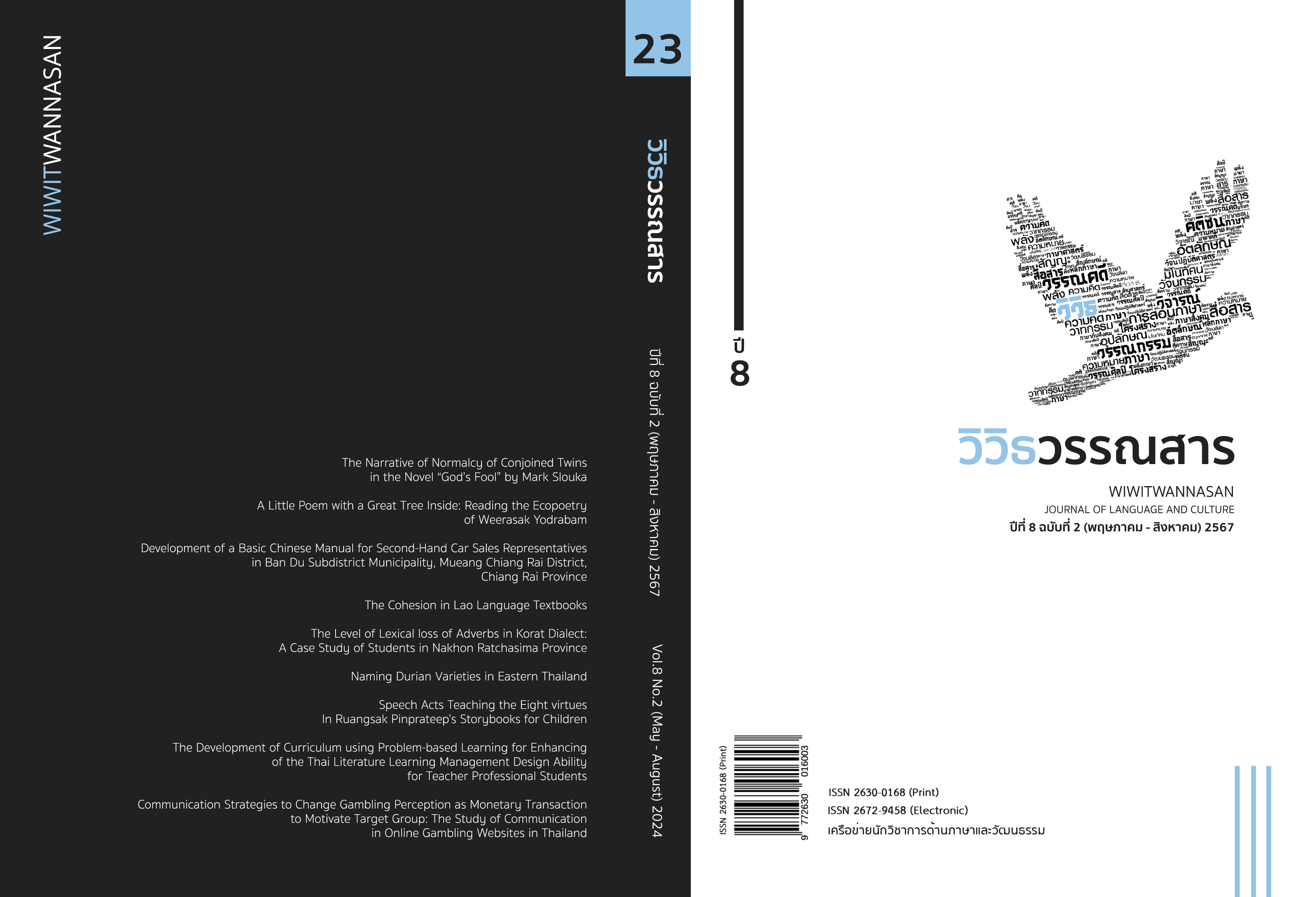การตั้งชื่อพันธุ์ทุเรียนในเขตภาคตะวันออกของไทย
Main Article Content
บทคัดย่อ
บทความวิจัยนี้มีวัตถุประสงค์เพื่อศึกษาที่มาและลักษณะทางภาษาที่ใช้ในการตั้งชื่อพันธุ์ทุเรียน โดยเก็บข้อมูลเฉพาะชื่อพันธุ์ทุเรียนในเขตภาคตะวันออก 3 จังหวัด ได้แก่ จันทบุรี ระยอง และตราด จากเว็บไซต์ของสำนักคุ้มครองพันธุ์พืช กรมวิชาการเกษตร (www.doa.go.th) จนได้ข้อมูลที่ใช้ในการศึกษา จำนวน 37 รายชื่อ
ผลการวิจัยด้านที่มาของการตั้งชื่อพันธุ์ทุเรียนในเขตภาคตะวันออก ผู้วิจัยใช้วิธีการสัมภาษณ์ผู้ยื่นคำขอขึ้นทะเบียน และใช้กรอบแนวคิดของ วิเชียร ทองพันชั่ง (Thongpanshang, 2003) เป็นแนวทางในการวิเคราะห์ข้อมูล พบว่า ที่มาของการตั้งชื่อพันธุ์ทุเรียนแบ่งออกเป็น 3 กลุ่ม โดยพบที่มาของการตั้งชื่อจำแนกเป็น 2 ที่มา มากที่สุด จำนวนทั้งสิ้น 20 รายชื่อ คิดเป็นร้อยละ 54.05 ได้แก่ การตั้งชื่อพันธุ์ทุเรียนตามสถานที่ และลำดับ พบ 8 ชื่อ คิดเป็นร้อยละ 21.62, ตั้งชื่อตามชื่อคน และลักษณะผลภายใน พบ 5 ชื่อ คิดเป็นร้อยละ 13.51, ตั้งชื่อตามชื่อคน และให้เป็นเอกลักษณ์ พบ 2 ชื่อ คิดเป็นร้อยละ 5.41, ตั้งชื่อตามชื่อคน และลักษณะผลภายนอก, ตั้งชื่อตามชื่อคน และตามวันสำคัญ, ตั้งชื่อตามลักษณะผลภายใน และให้เป็นเอกลักษณ์, ตั้งชื่อตามชื่อสัตว์ และให้เป็นเอกลักษณ์, ตั้งชื่อตามลักษณะผลภายนอก และตามสถานที่ พบลักษณะละ 1 ชื่อ คิดเป็นร้อยละ 2.70 รองลงมาพบที่มาของการตั้งชื่อจำแนกเป็น 1 ที่มา จำนวนทั้งสิ้น 9 รายชื่อ คิดเป็นร้อยละ 24.32 ได้แก่ การตั้งชื่อพันธุ์ทุเรียนตามลักษณะผลภายใน พบ 4 ชื่อ คิดเป็นร้อยละ 10.81, ตั้งชื่อตามชื่อคน พบ 3 ชื่อ คิดเป็นร้อยละ 8.11, ตั้งชื่อตามสถานที่ และตั้งชื่อให้เป็นเอกลักษณ์ พบลักษณะละ 1 ชื่อ คิดเป็นร้อยละ 2.70 และพบที่มาของการตั้งชื่อจำแนกเป็น 3 ที่มา จำนวน 8 รายชื่อ คิดเป็นร้อยละ 21.62 ได้แก่ การตั้งชื่อพันธุ์ทุเรียนตามชื่อคน ลักษณะผลภายใน และให้เป็นเอกลักษณ์, ตั้งชื่อตามลักษณะการเพาะพันธุ์ สถานที่ และลำดับ พบลักษณะละ 3 ชื่อ คิดเป็นร้อยละ 8.11, ตั้งชื่อตามชื่อคน ลักษณะผลภายนอก และต้นไม้ที่อยู่ใกล้กัน, ตั้งชื่อตามสถานที่ ชื่อคน และให้เป็นเอกลักษณ์ พบลักษณะละ 1 ชื่อ คิดเป็นร้อยละ 2.70 ตามลำดับ
ส่วนผลการวิจัยด้านลักษณะทางภาษาที่ใช้ในการตั้งชื่อพันธุ์ทุเรียนในเขตภาคตะวันออก ผู้วิจัยศึกษาโครงสร้างของชื่อพันธุ์ทุเรียนในเขตภาคตะวันออก ตามกรอบแนวคิดของ นววรรณ พันธุเมธา (Phanthumetha, 2016) และศึกษาที่มาของภาษาในการตั้งชื่อพันธุ์ทุเรียนในเขตภาคตะวันออก โดยใช้พจนานุกรมฉบับราชบัณฑิตยสถาน พ.ศ. 2554 ตำราที่เกี่ยวข้องกับคำยืมในภาษาไทย และการสัมภาษณ์ผู้รู้ เป็นเครื่องมือในการวิเคราะห์ข้อมูล ผลการวิจัยพบว่า โครงสร้างของชื่อพันธุ์ทุเรียนแบ่งออกเป็น 2 กลุ่ม ได้แก่ ชื่อพันธุ์ทุเรียนที่มีลักษณะโครงสร้างเป็นวลีหรือกลุ่มคำ พบมากที่สุดถึง 36 ชื่อ คิดเป็นร้อยละ 97.30 โดยแบ่งเป็นโครงสร้างแบบนามวลี พบ 29 ชื่อ คิดเป็นร้อยละ 78.38 รองลงมาเป็นโครงสร้างแบบกริยาวลี พบ 6 ชื่อ คิดเป็นร้อยละ 13.51 และโครงสร้างแบบกลุ่มคำ พบ 1 ชื่อ คิดเป็นร้อยละ 2.70 ตามลำดับ ส่วนชื่อพันธุ์ทุเรียนที่มีลักษณะโครงสร้างเป็นคำ พบเพียง 1 ชื่อ คิดเป็นร้อยละ 2.70 ซึ่งปรากฏเป็นคำนาม
ในด้านที่มาของภาษาที่ใช้ในการตั้งชื่อพันธุ์ทุเรียนในเขตภาคตะวันออก พบที่มาของภาษาที่ใช้ในการตั้งชื่อพันธุ์ทุเรียน 12 ลักษณะ เรียงลำดับการปรากฏจากมากไปหาน้อย ได้แก่ ชื่อภาษาบาลีสันสกฤต พบ 10 ชื่อ คิดเป็นร้อยละ 27.03, ชื่อภาษาไทยประสมกับภาษามอญ พบ 5 ชื่อ คิดเป็นร้อยละ 13.51, ชื่อภาษาไทยประสมกับภาษาบาลีสันสกฤต ชื่อภาษาเขมรประสมกับภาษาบาลีสันสกฤต ชื่อภาษามอญประสมกับภาษาบาลีสันสกฤต ชื่อภาษาไทยประสมกับภาษาเขมรและภาษาบาลีสันสกฤต พบลักษณะละ 3 ชื่อ คิดเป็นร้อยละ 8.11, ชื่อภาษาไทย ชื่อภาษาไทยประสมกับภาษาเขมร ชื่อภาษาเขมรประสมกับภาษามอญและภาษาบาลีสันสกฤต ชื่อภาษาจีน พบลักษณะละ 2 ชื่อ คิดเป็นร้อยละ 5.41, ชื่อภาษามอญประสมกับภาษาเขมร และชื่อภาษามลายู พบลักษณะละ 1 ชื่อ คิดเป็นร้อยละ 2.70
Article Details

อนุญาตภายใต้เงื่อนไข Creative Commons Attribution-NonCommercial-NoDerivatives 4.0 International License.
ลิขสิทธิ์ของบทความเป็นของวารสาร การพิมพ์ซ้ำจะต้องได้ร้บการอนุญาตจากบรรณาธิการวารสาร
เอกสารอ้างอิง
Ayaekaji, P. (2017). Diversity of Indigenous Durian Cultivars (Duriozibethinus Murray) in Lamphaya Sub-district, Mueang Yala District, Yala Province. Proceedings of the 6th National Research Conference on Research Creativity to Drive the Country towards Stability, Prosperity, and Sustainability in the Era of Thailand 4.0. Fatoni University. (In Thai)
Khaiyanan, W. (2004). Auspicious Plant Naming in Thai [Master's thesis]. Chulalongkorn University. (In Thai)
Office of Agricultural Economics. (2023). Agricultural Statistics of Thailand, 2022. Office of Agricultural Economics. https://www.oae.go.th/assets/portals/1/files/jounal/2566/yearbook2565.pdf (In Thai)
Pakdeekam, S. (2006). Loanword Dictionary of Khmer Words in Thai Language. Bangkok: Amarin Printing and Publishing. (In Thai)
Puurakasikara, W. (1998). The Characteristics of Thai Words of Mon Origin (Research). Thai Khadi Research Institute, Thammasat University. (In Thai)
Phanthumetha, N. (2016). Thai Grammar. 8th edition. Bangkok: Academic Publications Project, Faculty of Arts, Chulalongkorn University. (In Thai)
Royal Institute. (2013). Royal Institute Dictionary, 2011 Edition. Bangkok: Nanmee Books Publications. (In Thai)
Siriwitchaiporn, L. (2014). Research on Rice Varieties: Linguistic Genetics of Thai Beauty. Department of Language, Faculty of Arts, Rajamangala University of Technology Suvarnabhumi, Suphan Buri Campus. (In Thai)
Silpawattanatham. (January 26, 2022). Where does the name "Rayong" come from? Is it in the Chong or Malayu language?, Silpa-mag.https://www.silpa-mag.com/history/article_52770 (In Thai)
Thongpanshang, W. (2003). Durian. (3rd ed.). Nonthaburi: Kasetsarn. (In Thai)


